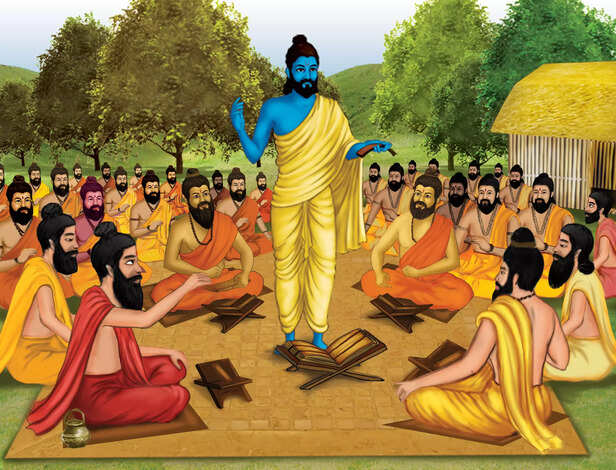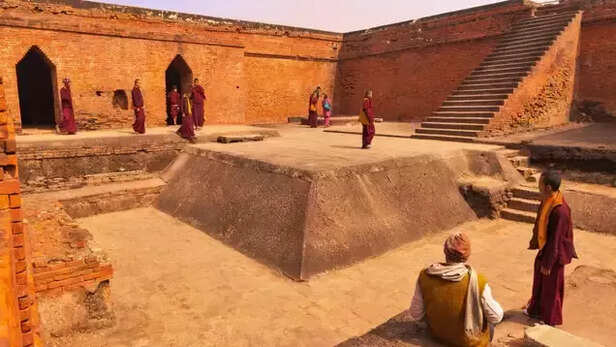Why India's Ancient Education System Was Ahead of Its Time
Riya Kumari | Jan 16, 2025, 19:55 IST
Gurukul
Okay, so picture this: it’s ancient India. No Wi-Fi, no TikTok, no coffee shops where you pretend to work but are actually eavesdropping on the table next to you. Just you, your scrolls, and a life that’s somehow more together than ours despite not having Google Calendar. And yet, ancient India’s education system was light-years ahead of us. Like, “how-did-we-go-from-that-to-this” ahead.
Imagine an education system that not only prepared you for a career but taught you how to live a meaningful, balanced life. A system that valued wisdom over rote memorization, character over competition, and holistic development over rigid specializations. This was the foundation of ancient India’s education system—a model so profound and forward-thinking that its echoes can still inspire the way we approach learning today. It wasn’t just about acquiring knowledge; it was about cultivating wisdom, values, and skills to contribute meaningfully to society.
Gurukuls

Forget your modern-day campuses with their overpriced meal plans and suspiciously sticky library desks. Back then, they had gurukuls. These weren’t just schools; they were full-on life boot camps. Students didn’t just learn math—they learned life. They’d wake up, meditate, study scriptures, learn how to wield a bow and arrow, maybe churn some butter. You know, the usual. It wasn’t about “Can you memorize all the rivers in Asia for a standardized test?” It was more like, “Can you balance your inner peace while chopping wood and reciting the Vedas?” And guess what? No tuition fees. You paid your guru with your service. You cooked, cleaned, and worked in exchange for knowledge. Subjects weren’t taught in isolation. A student studying mathematics might also learn philosophy, music, agriculture, and martial arts. This is what we now call holistic education
Multidisciplinary Learning

The ancient system didn’t believe in shoving you into a single career box. You could be a poet, a mathematician, and a sword-wielding warrior all at once. Who needs a “side hustle” when your main hustle is everything? Take Nalanda and Takshashila, for instance. These universities weren’t just some “three professors and a cow” situation. They had international students coming from places like China, Greece, and Persia. They studied everything from astronomy to medicine, linguistics to politics. Essentially, they were the original global education hubs—minus the student debt and mediocre campus food. This cross-pollination of ideas created thinkers who could connect the dots between diverse fields, a skill that remains invaluable in today’s complex, interconnected world.
Practicality Was Their Middle Name

Here’s where it gets truly mind-blowing: the focus was on practical knowledge. None of this “solve for X” nonsense you never use. Agriculture, metallurgy, architecture, statecraft, and medicine were taught alongside spiritual practices like meditation and yoga. Students learned how to lead a self-sufficient life, contribute to their community, and make ethical decisions. Because apparently, back then, the goal of education was to prepare you for life, not just to ace exams you’d forget the second you walked out of the classroom. Also, they had this thing called dialogue. Students weren’t just passive listeners; they debated, questioned, and challenged ideas. Imagine having a heated discussion about metaphysics without anyone pulling out their phone to Google the answer. Wild, right?
Inclusion, Sort Of

Now, I won’t pretend it was a perfect system. There were some less-than-stellar aspects, like caste-based exclusions that scream, “Yikes!” But it’s worth noting that in certain pockets, women had access to education too. Female scholars like Gargi and Maitreyi were out there, dropping wisdom bombs and proving that brains aren’t gendered.
Why We Should Care

So why does any of this matter now? Because somewhere between ancient gurukuls and modern exam factories, we lost the plot. We stopped teaching people how to think and started teaching them what to think. Creativity got sidelined, curiosity became optional, and everyone’s just trying to “secure a package,” as if life is an Amazon delivery. Maybe it’s time we took a leaf out of ancient India’s book—literally. Let’s bring back multidisciplinary learning. Let’s value wisdom over rote learning. And for the love of all things holy, can we please stop pretending that knowing trigonometry is a survival skill?
Gurukuls

Gurukul
Forget your modern-day campuses with their overpriced meal plans and suspiciously sticky library desks. Back then, they had gurukuls. These weren’t just schools; they were full-on life boot camps. Students didn’t just learn math—they learned life. They’d wake up, meditate, study scriptures, learn how to wield a bow and arrow, maybe churn some butter. You know, the usual. It wasn’t about “Can you memorize all the rivers in Asia for a standardized test?” It was more like, “Can you balance your inner peace while chopping wood and reciting the Vedas?” And guess what? No tuition fees. You paid your guru with your service. You cooked, cleaned, and worked in exchange for knowledge. Subjects weren’t taught in isolation. A student studying mathematics might also learn philosophy, music, agriculture, and martial arts. This is what we now call holistic education
Multidisciplinary Learning

Nalanda
The ancient system didn’t believe in shoving you into a single career box. You could be a poet, a mathematician, and a sword-wielding warrior all at once. Who needs a “side hustle” when your main hustle is everything? Take Nalanda and Takshashila, for instance. These universities weren’t just some “three professors and a cow” situation. They had international students coming from places like China, Greece, and Persia. They studied everything from astronomy to medicine, linguistics to politics. Essentially, they were the original global education hubs—minus the student debt and mediocre campus food. This cross-pollination of ideas created thinkers who could connect the dots between diverse fields, a skill that remains invaluable in today’s complex, interconnected world.
Practicality Was Their Middle Name

Yoga
Here’s where it gets truly mind-blowing: the focus was on practical knowledge. None of this “solve for X” nonsense you never use. Agriculture, metallurgy, architecture, statecraft, and medicine were taught alongside spiritual practices like meditation and yoga. Students learned how to lead a self-sufficient life, contribute to their community, and make ethical decisions. Because apparently, back then, the goal of education was to prepare you for life, not just to ace exams you’d forget the second you walked out of the classroom. Also, they had this thing called dialogue. Students weren’t just passive listeners; they debated, questioned, and challenged ideas. Imagine having a heated discussion about metaphysics without anyone pulling out their phone to Google the answer. Wild, right?
Inclusion, Sort Of

Takshashila
Now, I won’t pretend it was a perfect system. There were some less-than-stellar aspects, like caste-based exclusions that scream, “Yikes!” But it’s worth noting that in certain pockets, women had access to education too. Female scholars like Gargi and Maitreyi were out there, dropping wisdom bombs and proving that brains aren’t gendered.
Why We Should Care

Teach
So why does any of this matter now? Because somewhere between ancient gurukuls and modern exam factories, we lost the plot. We stopped teaching people how to think and started teaching them what to think. Creativity got sidelined, curiosity became optional, and everyone’s just trying to “secure a package,” as if life is an Amazon delivery. Maybe it’s time we took a leaf out of ancient India’s book—literally. Let’s bring back multidisciplinary learning. Let’s value wisdom over rote learning. And for the love of all things holy, can we please stop pretending that knowing trigonometry is a survival skill?
